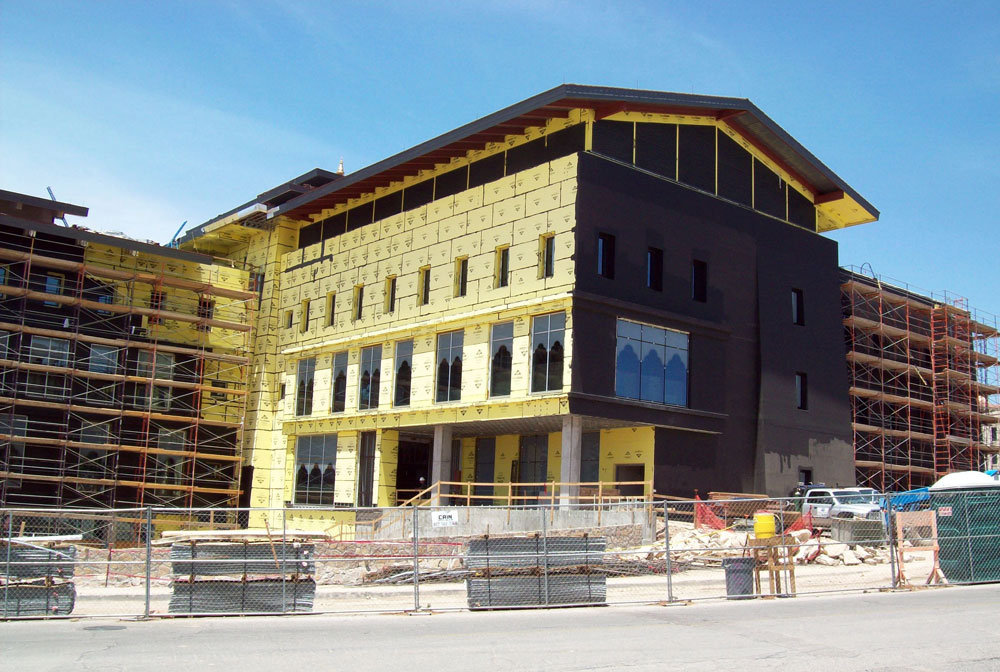EL PASO, Texas — A state-of-the-art, 210,000 square foot facility for the University of Texas at El Paso School of Nursing and College of Health Sciences is set to open its doors on Wiggins Way, across the street from the library in the area where the Student Health Center used to be.
The 40-year-old converted Hotel Dieu currently serving as the UTEP College of Health Science and Nursing Program headquarters is insufficient spatially to accommodate its nearly 2,500 students and 150 faculty and staff, UTEP administrators contend. Moreover, its one-and-a-half-mile distance from the main campus has presented logistical problems for those who commute to and from it.

The new facility for the School of Nursing will be able to host 3,491 students and 139 faculty, their expected population by 2015. (Phillip Henderson/Borderzine.com)
According to a UTEP 2007 Facility Proposal, “the quality of healthcare in the Paso del Norte region relies heavily on UTEP’s capacity to prepare graduates in a broad range of health professions programs.” Such programs include: nursing, physical therapy, speech/language pathology, pharmacy, occupational therapy, kinesiology, health promotion and clinical laboratory science. Pursuant to graduation, a substantial portion of UTEP health graduates stay in the Paso del Norte region.
To aid in increasing the number of qualified health professionals, UTEP has expanded various programs and admitted more students, causing the need for the new facility. It also has developed “creative program delivery strategies” such as “online courses and an accelerated B.S. in Nursing program,” declares the proposal.
Others, too, have weighed in on responding to the growing demands, including hospitals in El Paso owned by investors, who have assisted by providing scholarships for students and assisting in recruitment and retention of faculty.
Yet, according to the proposal, “despite these many efforts,” the regional demand remains and is growing.
The new facility will respond to the current needs of both departments, as well as “permit their expansion” mostly by means of additional space. Additionally, it will be located close to two major hospitals and medical office complexes, which, according to the proposal “will enable the largely undergraduate student population [in both departments], (nearly 90 percent of the total enrollment), to attend class, receive advising and faculty mentoring,” as well as cut down on commuting time from the present off-campus location.
“I think it’s a win-win. We can expand student enrollment, space and research,” said UTEP Nursing Dean Elias Provencio-Vasquez. “The new facility will be student-friendly, is high tech and closer to campus.” Provencio-Vasquez, who holds a Ph.D. in nursing and had been the Associate Dean of Academia for Nursing at the University of Miami previously, was recommended by the former UTEP Nursing Dean and has been at the university for seven months.
One of the most important educational improvements for the students is a simulator lab, which will contain “dummy” human bodies capable of responding like real humans to the actions of the students.
“It’s a great learning opportunity,” said Dean Provencio-Vasquez, calling the simulator the “hallmark” of the new facility.
Among other advantages, according to the proposal, “new facilities will expand capacity to conduct externally funded research” via “interdisciplinary research centers.” “New grant award funding is expected to increase by 50 percent” to 6,382 in 2015.
Projected student and faculty enrollment for both departments in total by 2015 is estimated to be at least 3,491 for students and 139 for faculty. Increases in enrollment are expected to be at graduate levels especially, with “330 additional Master’s students,” an increase from the current 261, and 160 Ph.D. students, an increase from the present 15. However, a 30 percent increase in undergraduate enrollment in each the three bachelor’s degree level nursing programs is projected also, in addition to a new program enabling “licensed practical nurses to achieve the BSN degree.”
The new facility’s proximity to the main campus “will foster the growth of interdisciplinary clinical research and academic programs,” ranging from MBAs for “public health leaders” to Ph.D.s in Gerontology and Nursing Practice.
“I believe that, since it is a bigger building than the one on Campbell, it will offer many new things like better technology, as well as better access to more research for the students, which will enhance our education,” said third-year nursing student Rebecca Flores, adding “I like that the building will be on campus now instead of on Campbell. We won’t be isolated from the rest of the school anymore.”
